-
Jira: Best for Agile development teams
-
Confluence: Best for knowledge management and collaboration
-
monday.com: Best for visually-driven project management
-
Teamwork: Best for client-facing businesses
-
ClickUp: Best for customizability
-
Notion: Best for versatile workspace management
As project management tools become increasingly essential for businesses, finding the right solution is critical to success. Asana has long been a popular choice for managing projects, but many companies are seeking alternative platforms that better suit their unique needs.
In this article, we explore the top six Asana alternatives available in 2023, offering a mix of free and paid options with diverse features for different industries and use cases. We offer information on pricing, key features and pros and cons to help you make an informed decision.
SEE: Use this project manager hiring kit to find the right person to lead your project teams.
Asana vs. the best alternatives
This comparison table offers a quick overview of the key features and starting prices of the top six Asana alternatives. Compare and contrast the options to find the one that suits your business needs.
| Software | Task management | Time tracking | Collaboration and communication | File sharing and storage | Customizable workflows | Pricing (billed monthly) |
|---|---|---|---|---|---|---|
| Asana | Yes | Limited | Yes | Yes | Yes | Free plan available Paid plans start at $13.49 per user |
| Jira | Yes | Limited | Yes | Yes | Highly customizable | Free plan available Paid plans start at $7.75 per user |
| Confluence | Limited | No | Yes | Yes | Limited | Free plan available Paid plans start at $5.75 per user |
| monday work management | Yes | Yes | Yes | Yes | Yes | No free plan Paid plans start at $10 per user |
| Teamwork | Yes | Yes | Yes | Yes | Yes | Free plan available Paid plans start at $8.99 per user |
| ClickUp | Yes | Yes | Yes | Yes | Highly customizable | Free plan available Paid plans start at $9 per user |
| Notion | Yes | No | Yes | Yes | Highly customizable | Free plan available Paid plans start at $10 per user |
Jump to:
- Why choose an Asana alternative?
- How to choose the best Asana alternative for your business
- How we evaluated Asana competitors
Jira: Best for Agile development teams

Jira is a powerful project management tool designed specifically for software development teams. It’s widely popular for its agile approach, including Scrum and Kanban methodologies. With a customizable platform, advanced reporting capabilities and seamless integration with other Atlassian tools, Jira has become an industry standard for software development project management.
SEE: For a more detailed look, check out our in-depth comparison of Asana and Jira.
Pricing
- Free: $0 for 10 users for the monthly subscription only.
- Standard: $7.75 per user per month billed monthly. $790 annually for one to 10 users.
- Premium: $15.25 per user per month billed monthly. $1,525 annually for one to 10 users.
- Enterprise: Only billed annually. Available for teams with more than 800 users. Contact Jira sales for pricing details.
Key features
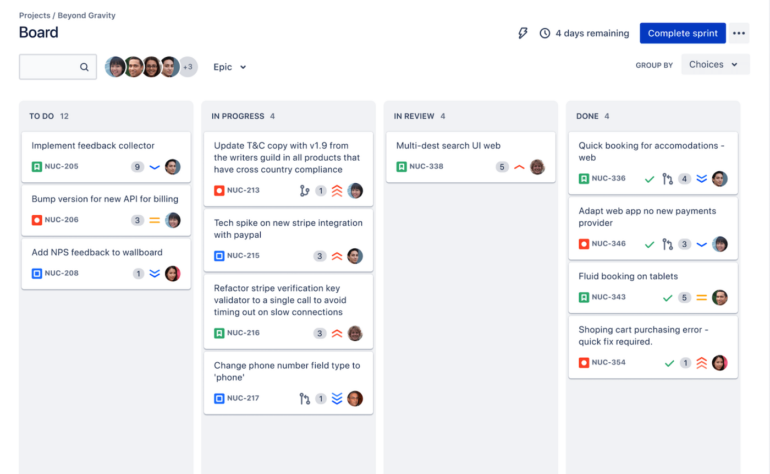
- Agile project management capabilities: Offers built-in scrum and kanban boards for seamless planning, tracking and releasing of software.
- Customizable workflows: Enables users to create and tailor workflows to suit their team’s unique processes, with the ability to add custom fields, statuses and transitions.
- Advanced reporting and analytics: Allows teams to measure their performance, identify bottlenecks and improve their processes continuously.
- Robust integration ecosystem: Connects seamlessly with other Atlassian tools such as Confluence, Bitbucket and Trello as well as popular third-party apps like Slack, GitHub and Google Workspace.
Pros
- Highly customizable and scalable regardless of size or complexity.
- Designed for software development projects, making it well suited for managing complex software projects.
- Powerful workflow automation helps streamline repetitive tasks and processes, increasing efficiency and reducing the likelihood of human errors.
Cons
- Steeper learning curve for new users due to Jira’s advanced features and customizations.
- Not as well suited for non-technical teams as its primary focus is on software development.
Confluence: Best for knowledge management and collaboration
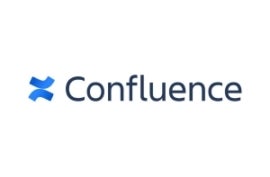
Confluence, an Atlassian product, is a powerful collaboration and documentation platform that integrates seamlessly with Jira and other Atlassian tools. Although it’s not specifically designed for project management, Confluence is an excellent choice for teams looking to centralize and streamline their documentation and knowledge-sharing processes.
SEE: For more information, check out our full Confluence review.
Pricing
- Free: $0 for 10 users for the monthly subscription only.
- Standard: $5.75 per user per month billed monthly. $580 annually for one to 10 users.
- Premium: $11 per user per month billed monthly. $1,100 annually for one to 10 users.
- Enterprise: Only billed annually. Available for teams with more than 800 users. Contact Confluence sales for pricing information.
Key features
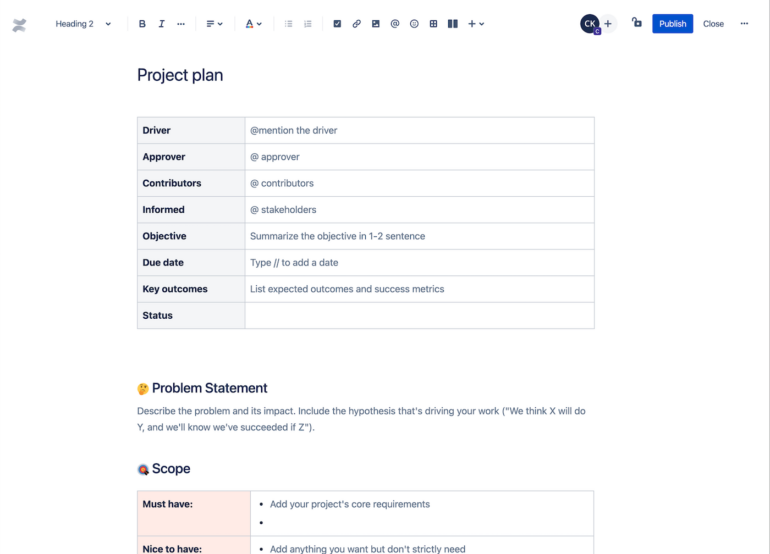
- Comprehensive knowledge base: Enables users to create and organize team documentation from a single platform.
- Real-time collaborative editing: Allows multiple team members to work on a document simultaneously.
- Integration with Jira: Enables seamless communication between project management and documentation.
- Customizable templates and macros: Speeds up content creation for a more efficient workflow.
Pros
- Intuitive user interface, making it easy for both technical and non-technical users to create and collaborate on documents.
- Strong integration with Jira and other Atlassian tools for a seamless experience.
- Version control and audit logs for tracking changes and maintaining documentation history.
Cons
- Not specifically designed for project management, which may require integration with another tool like Jira for full functionality.
- Lacks some advanced project management features such as Gantt charts and built-in time tracking.
monday.com: Best for visually-driven project management

monday work management is a popular and visually appealing project management platform that offers a variety of features tailored to teams across various industries. Its versatility and ease of use make it an excellent Asana alternative for companies seeking a more visually-driven project management solution. It’s also worth considering for teams searching for a more engaging and adaptable project management solution.
SEE: For a closer look, check out our in-depth comparison of Asana and monday work management.
Pricing
- Individual: Free forever for up to two seats.
- Basic: $8 per seat per month, billed annually, or $10 per seat billed monthly.
- Standard: $10 per seat per month, billed annually, or $12 per seat billed monthly.
- Pro: $16 per seat per month, billed annually, or $20 per seat billed monthly.
- Enterprise: Contact monday work management sales for pricing information.
Key features
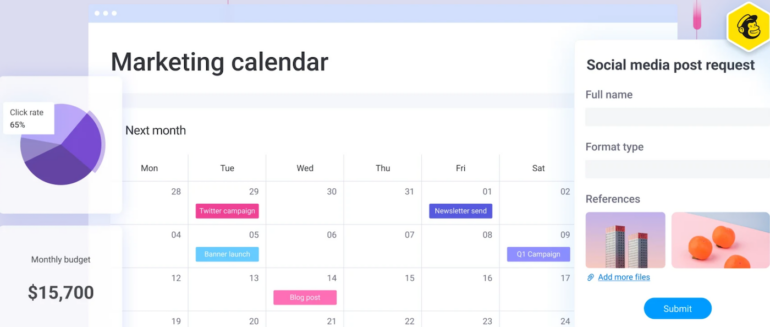
- Customizable, visually-driven boards: Enables users to visually organize data for their project management needs.
- Multiple views: Provides multiple view types, including Gantt charts, timelines and calendars.
- Workflow automation: Reduces manual tasks to streamline progress on project tasks.
- Integrations: Integrates with popular tools like Google Drive, Slack and Zoom.
- Advanced reporting and analytics: Enables data-driven decision-making, so project leaders can keep up with task progress and team performance.
Pros
- Intuitive, visually engaging interface.
- Highly adaptable to different industries and team sizes.
- Wide range of templates and views for managing projects.
Cons
- Limited functionality in the free version.
- Can become expensive for larger teams.
Teamwork: Best for client-facing businesses

Teamwork stands out as an ideal choice for businesses seeking a comprehensive suite of project management and collaboration tools. Its feature-rich platform combines task management, time tracking and invoicing in one place, making it easy to manage projects from start to finish. Team collaboration is also a breeze with built-in chat, file sharing and document editing capabilities.
SEE: For more information, check out our full Teamwork review.
Pricing
- Free forever: Free forever for up to five users.
- Starter: $5.99 per user per month, billed annually, or $8.99 per user billed monthly.
- Deliver: $9.99 per user per month, billed annually, or $13.99 per user billed monthly.
- Grow: $17.99 per user per month, billed annually, or $24.99 per user billed monthly.
Key features
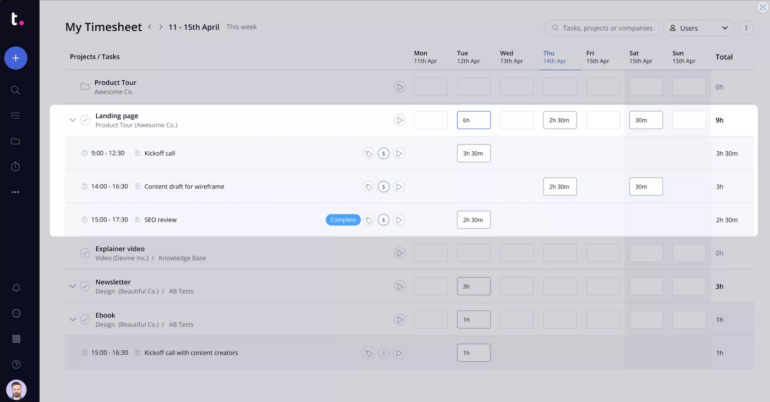
- Multiple views: Enables flexible project management with task lists, boards and Gantt charts.
- Built-in time tracking and invoicing: Lets project managers keep track of who has done what and when.
- Collaboration tools: Allows users to work together on projects with built-in tools like chat and document management.
- Customizable dashboards and advanced reporting: Helps project managers view project details and progress from a single platform.
Pros
- All-in-one solution for project management, collaboration and client communication.
- User-friendly interface with drag-and-drop functionality.
- Excellent customer support and resources.
- Scalable for businesses of all sizes.
Cons
- Some advanced features are available only on higher-tier plans.
- Initial setup and customization may be time-consuming.
ClickUp: Best for customizability

ClickUp is an ideal choice for businesses looking for a comprehensive all-in-one solution to streamline their project management, collaboration and productivity efforts. Its highly customizable interface and diverse set of features make it suitable for various industries and team sizes. Users can choose from multiple task views, create custom fields and statuses, track time and even manage goals and Objectives and Key Results within the platform.
SEE: For a closer look, check out our in-depth comparison of Asana and ClickUp.
Pricing
- Free: Free forever for personal use, allowing an unlimited number of users.
- Unlimited: $5 per user per month, billed annually, or $9 per user billed monthly.
- Business: $12 per user per month, billed annually, or $19 per user billed monthly.
- Business Plus: $19 per user per month, billed annually, or $29 per user billed monthly.
- Enterprise: Contact ClickUp sales for pricing information.
Key features
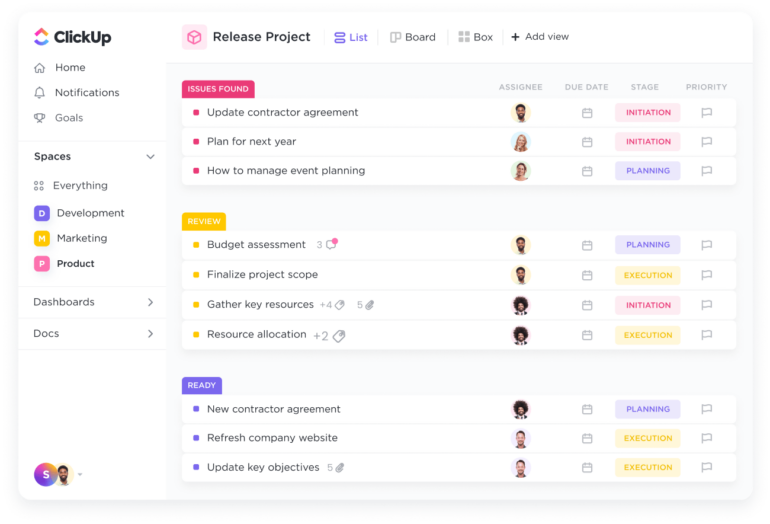
- Multiple views: Provides view types such as List, Board, Box, Gantt and Calendar among others.
- Custom field creation for tasks: Enables users to track information related to their projects.
- Goal and milestone features: Ensures teams are in line to hit their objectives.
- Automation and integrations: Enables streamlined project planning with automation capabilities and integrations with over 1,000+ apps.
Pros
- Comprehensive all-in-one platform for project management, collaboration and productivity.
- Highly customizable and flexible to suit various teams and industries.
- Generous free plan with an unlimited number of users.
- User-friendly interface and onboarding experience.
Cons
- The extensive feature set might be overwhelming for some users.
- Occasional performance issues with large projects.
Notion: Best for versatile workspace management

Notion is an all-in-one workspace that combines the functionalities of a project management tool, documentation platform and collaboration space. It’s perfect for businesses that want a centralized place for teams to collaborate on projects, documents and tasks while maintaining a clear overview of their work.
SEE: Learn more about how to use Notion for project management.
Pricing
- Free: Unlimited blocks for individuals but limited block trials for teams.
- Plus: $10 per user per month billed monthly and $8 per user per month billed annually.
- Business: $18 per user per month billed monthly and $15 per user per month billed annually.
- Enterprise: Contact Notion for a demo, a trial and for pricing information for this plan.
- Notion AI: An add-on to any paid plan at $8 per member per month for annual billing and $10 per member per month for monthly billing and free plans.
Key features
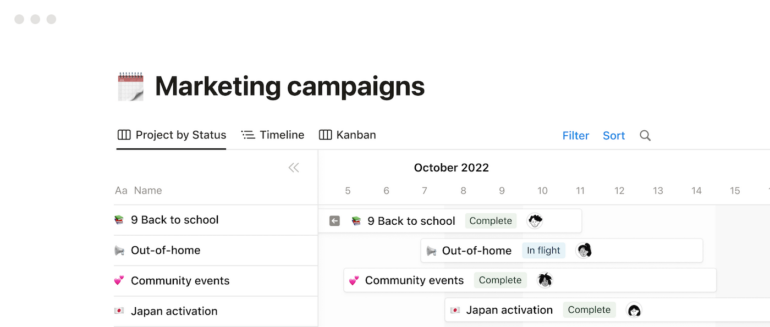
- Drag-and-drop interface: Lets users build flexible, customizable workspaces.
- Multiple view types: Offers kanban boards, tables, lists and calendar views for project management.
- Multimedia support and collaboration: Enables rich content creation with multimedia support and real-time collaboration.
- Advanced search and filtering options: Allows users to search for tasks and other details within a project.
Pros
- Highly flexible and customizable to suit various workflows.
- Offers an all-in-one solution for project management, documentation and collaboration.
- User-friendly interface for both technical and non-technical users.
Cons
- Lacks native Gantt charts and time-tracking features.
- Steeper learning curve due to the high level of customization.
Why choose an Asana alternative?
While Asana is an excellent project management tool with a wide range of features, there are various reasons why a company might look for alternatives. Understanding these reasons will help you make an informed decision when selecting the right project management software for your organization.
Cost
Asana’s pricing may not fit within the budget of some small businesses or startups. By exploring alternatives, you might find more cost-effective options or even free plans that better align with your financial constraints without sacrificing essential features.
Specialized features
Different teams have unique requirements depending on their industry and work processes. Asana may not cater to every specialized need and finding an alternative tailored to your team’s specific requirements can lead to greater efficiency and effectiveness.
SEE: Check out our list of the best creative project management software.
Learning curve
Asana is user-friendly, but it might still have a learning curve for some team members. If your team struggles to adapt to Asana’s interface or features, you may find better success with a more intuitive or simplified alternative.
Integrations
Although Asana integrates with a variety of third-party apps, some alternatives may offer better compatibility with the tools your team is already using. Seamless integration with your existing tech stack can save time and improve overall productivity.
Customization
Some organizations may require higher levels of customization in their project management tool. In such cases, finding an alternative with more flexible and customizable features can make a significant difference in how your team manages projects and workflows.
Scalability
As your company grows, you might find that Asana no longer meets your evolving needs. By exploring alternatives, you can discover a more scalable solution that can accommodate your expanding team and projects.
How to choose the best Asana alternative for your business
Selecting the right project management tool for your organization is essential for maximizing efficiency, communication and overall success. There’s no one-size-fits-all solution, so consider the following factors when choosing the best Asana alternative for your business:
Identify your team’s needs and requirements
Before comparing alternatives, list your team’s specific needs, such as collaboration, time tracking, or issue tracking. This will help you prioritize features that are most important to your organization, making it easier to choose the best-fit tool.
Consider your industry and company size
Some project management tools are tailored for specific industries, while others cater to small or large teams. Choose a platform that aligns with your industry’s best practices and can accommodate your team size as your company grows.
Evaluate ease of use and learning curve
Some project management tools offer advanced features, but their complexity can hinder adoption. Consider whether your team can quickly learn and adapt to the chosen platform. A user-friendly interface can increase team engagement and streamline project management processes.
Assess integration capabilities
Integration with other software tools your company uses, such as customer relationship management, enterprise resource planning or communication platforms, can greatly enhance productivity. Examine the available integrations of each Asana alternative and consider how well they’ll mesh with your existing systems.
Determine your budget
The cost of project management tools varies greatly. Establish your budget and consider the pricing structure, such as per-user or tiered pricing. Also, factor in any additional costs that may arise, such as training or add-ons.
Considering these factors will help you make an informed decision on the best Asana alternative for your business. Ultimately, the chosen tool should enhance team collaboration, improve workflow efficiency and support your organization’s growth.
How we evaluated Asana competitors
In order to identify the best Asana alternatives for 2023, our evaluation focused on several critical factors. Aiming to ensure that the recommended alternatives cater to a wide range of businesses and meet various project management needs, the criteria included evaluating feature sets, usability and user experience, integrations, price and value for money alongside customer reviews and support.
These factors guided our compilation of these six top alternatives to Asana for 2023. Each of these tools excels in different areas and caters to specific use cases, ensuring businesses can find a project management solution that aligns with their unique requirements.
Still not sure if any of these tools are right for your business? Check out our list of the top cloud-based project management tools.








